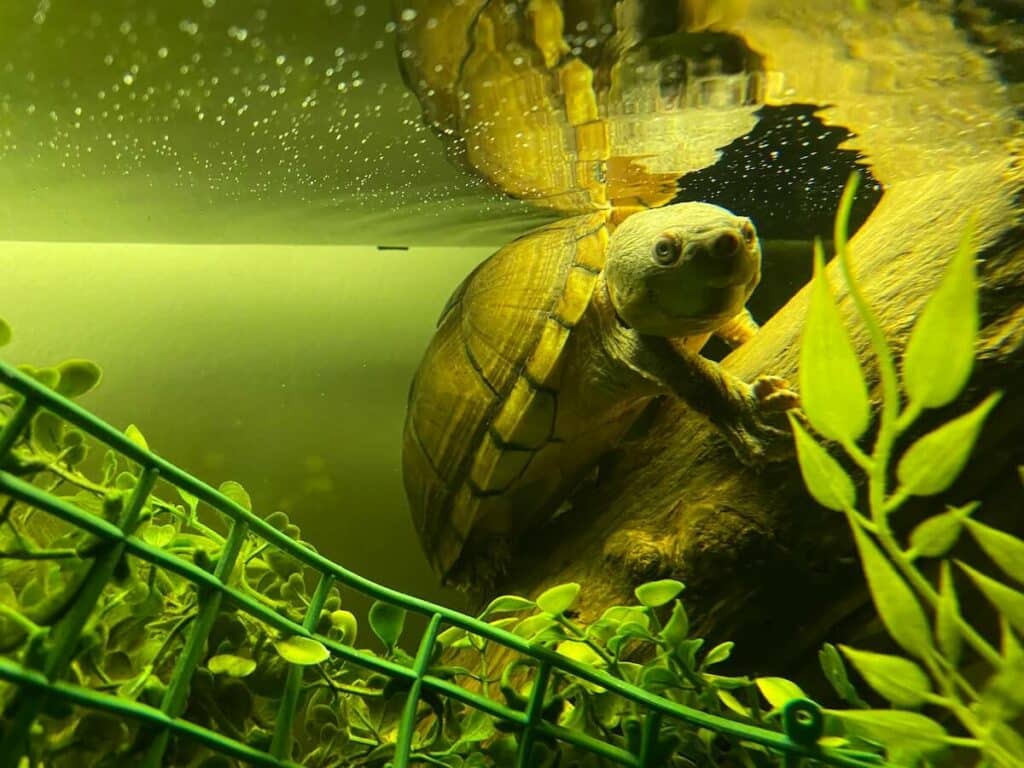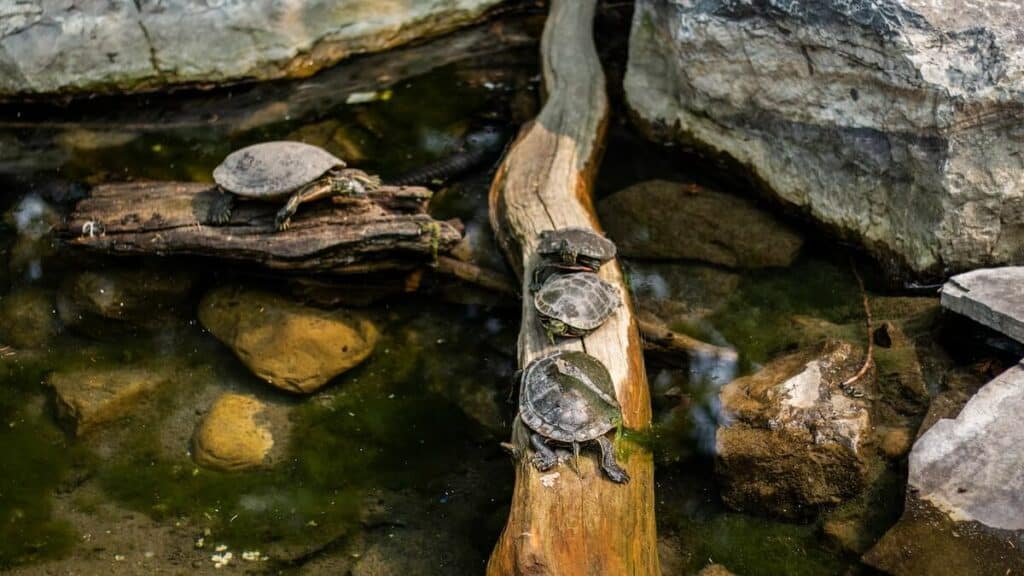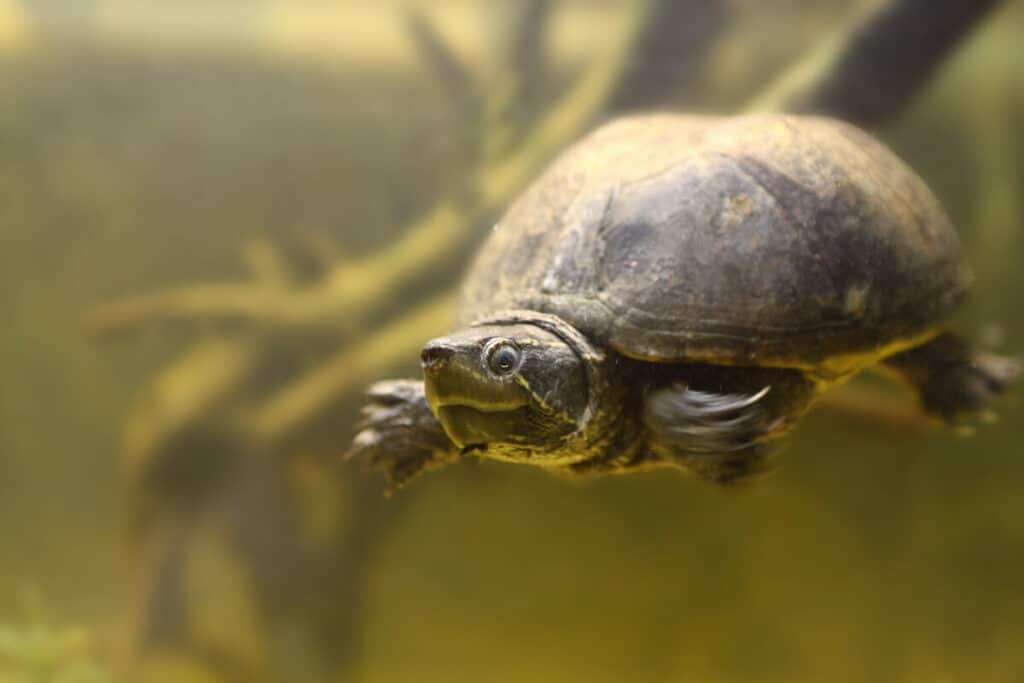the essentials in brief
A musk turtle in the aquarium requires sufficient space, appropriate water temperature, land and water areas, and a varied and balanced diet. Read more here...
When keeping a musk turtle, you need to pay attention to water quality, proper UV-B lighting, sunbathing opportunities, a varied diet, and adequate hiding places.
Musk turtles can be kept in company, but it is important to provide enough space and hiding places to minimize conflict; but they can also be kept alone without any problems. Read more here...
Are you ready to dive into the fascinating world of musk turtles? These mysterious creatures have a long history and offer us a glimpse into life beneath the surface that is full of surprises. In this blog post, we will tell you everything there is to know about musk turtles, from their fascinating characteristics to their impact on the ecosystems they live in.
The diversity of musk turtles: discover different species

The world of musk turtles is amazingly diverse, with an impressive range of species native to different parts of the world. Each species has its own unique traits and adaptations that it has adapted to its specific habitat. Let's take a closer look at some of these fascinating species:
- The Red Musk Turtle (Sternotherus odoratus): This species is native to North America and stands out because of its bright red coloration. Red musk turtles are excellent swimmers and prefer slow-moving bodies of water such as rivers and streams. They are excellent at adapting to their environment, using their color and pattern to hide from predators.
- Pygmy Musk Turtle (Sternotherus minor): As the name suggests, this species is a small tortoise found in the southern United States. Despite their small size, pygmy musk turtles are bold hunters, feeding on aquatic insects and other small prey. Their compact build and bright colors make them charming pond and wetland residents.
- Chinese three-banded musk turtle (Chinemys reevesii): This species is native to East Asia, especially China and Taiwan. It owes its name to the three distinctive yellow stripes on its head and shell. Three-banded musk turtles are often popular pets, but it's important to realize that they require special care and environmental requirements in order to lead a healthy life.
The Mystery of the Name: Why "Musk"?
The name "musk turtle" might seem confusing at first, as we usually associate the smell of musk with perfumes and fragrances. But the name has an interesting explanation.
When musk turtles feel threatened or to be stressed, single them out special glands on the thighs and in the anal area away. This liquid has a strong odor, reminiscent of musk. This defense mechanism is intended to deter potential predators and give the turtles the opportunity to withdraw from dangerous situations.
Additional information: Musk turtles are most active during the active part of the day, so be prepared to spot them exploring and swimming.
This unique ability has given the musk turtle its name and is a fascinating example of how animals in nature evolve various adaptations to protect themselves and survive. So the name musk turtle not only has a beautiful ring to it, but also an interesting story.
Habitat and behavior: Insights into their way of life
Musk turtles are fascinating inhabitants of various waters and their way of life is as exciting as it is diverse. The animals are comfortable in a variety of habitats, including lakes, rivers, ponds, and even slow-moving streams. Their adaptability to different environments is remarkable and is reflected in their behavior.
Musk turtles are excellent swimmers and can move easily in both shallow and deep water. They use their strong legs and powerful flippers to gracefully move through the water.
Their diet consists primarily of a variety of aquatic plants, small insects, worms, and crustaceans. This varied diet helps maintain ecological balance in aquatic ecosystems.
Attention: Avoid bringing moss into the aquarium from natural bodies of water, as it could transmit diseases or parasites to your musk turtles. Instead, make sure that all elements in the aquarium are thoroughly cleaned and disinfected.
Interestingly, musk turtles are also known as scavengers. This means that they eat the carcasses of animals that have already died. This unusual feeding habit helps remove dead organisms from the water bodies, which in turn helps clean up the habitats.
Another fascinating behavior of musk turtles is their ability to hide near aquatic plantsto avoid possible dangers. Their shell is often overgrown with algae or aquatic plants, giving them excellent camouflage. When threatened, they retreat into their shell to protect themselves from enemies.
Importance for ecosystems: Musk turtles as key players
Musk turtles play an important role in the aquatic ecosystems in which they live. your vOccurrence and their behavior have far-reaching effects on biodiversity and the balance of these habitats.
Because musk turtles feed on aquatic plants, they help control algae growth. Excessive growth of algae can lead to ecological problems such as a lack of oxygen in water bodies. Through Musk turtles contribute to the regulation of plant growth to maintain the ecological balance at.
Note: Make sure that the water in the aquarium is regularly brought to the right temperature, as musk turtles depend on constant heat.
In addition, musk turtles are part of the food chain themselves. They serve as prey for various predators such as birds, larger fish, and even mammals. Their contribution to the food chain is essential for the proper functioning of aquatic ecosystems.
The protection of musk turtles is therefore not only important, to protect these fascinating animals, but also to maintain the health and stability of their habitats. When we recognize the importance of musk turtles as key players in ecosystems, we can better understand how closely connected and delicate the balance is in nature.
Keeping musk turtles in the aquarium: tips for species-appropriate keeping

Keeping musk turtles in the aquarium requires careful planning and attention to ensure that these fascinating animals live healthy and happy lives. Here are some important things to consider when considering keeping musk turtles as pets in your aquarium:
Habitat in the aquarium: Musk turtles need enough space to move and swim freely. An aquarium of at least 150 liters is recommended for a single adult animal. The more space is available, the better.
water quality: Water quality is very important for the well-being of musk turtles. A good filter is necessary to keep the water clean and free from contaminants. Regular partial water changes are also important to keep the water quality at a high level.
Water temperature and lighting: Musk turtles are cold-resistant animals that prefer water temperatures between 20 and 26 degrees Celsius. UV-B lighting is important for the turtles to be able to produce enough vitamin D3, which is important for the health of their bones and shell.
Tip: Make sure that the land and water areas in the aquarium are easily accessible so your musk turtles can easily move between the two areas.
Land and water areas: Musk turtles require both land and aquatic areas in the aquarium. Provide them with a flat area of land where they can sunbathe and rest. This is particularly important as musk turtles regularly go ashore to warm up.
Nutrition: The diet of musk turtles should be varied. They eat a mixture of aquatic plants, insects, worms and occasionally meat. Eat a balanced diet to ensure they get all the nutrients they need.
Conspecifics and society: Musk turtles can be kept alone as they don't necessarily need company. In fact, they tend to be territorial, especially during the mating season. If several musk turtles are to be kept together, it is important to ensure that the aquarium is large enough and offers enough hiding places to minimize aggression.
Vet visits: Regular vet check-ups are important to ensure your musk turtles are healthy. An experienced reptile veterinarian can help you with questions about health care and disease prevention.
An underwater world full of surprises
The musk turtles are truly fascinating creatures that give us a glimpse of the wonders of the aquatic world. Their diverse properties, their impact on ecosystems, and the threats they face make them an important topic worth learning more about. By increasing your knowledge of musk turtles and working to protect them, you can help preserve these amazing creatures for generations to come.



